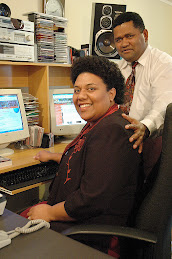
SURVIVOR of New Zealand's worst boating mishap was devasted yesterday to find out the Fijian man who saved her life is now dead.
Katherine MacGibbon, of Queenstown, in New Zealand, said, "I never got to say thank you for that," she said when contacted late yesterday.
"If I had found him after the incident I would have flown all the way to Fiji just to say thank you," she said. "I feel really sad about this (his death). I feel devastated. I hoped and prayed that he was still alive so that I could say thank you."
Katherine, who is now known as
Kate Watson, was only 19 when the inter-island ferry Wahine capsized and sank,taking with it 51 lives, 40 years ago today.
She remembers seeing bodies floating beside her as she and others were saved in rough seas in of the worst storms to have hit New Zealand.
She clearly remembers how she was saved by a "big Fijian man she knew as Eroni Vaceucau".
That man was
Ratu Eroni Vakacegu, of Namata Village, Raralevu, Tailevu.
Bau chief, relative and school mate in Levuka Public and later Wanganui College, in New Zealand, Ratu Tu'uakitau Cokanauto, said Ratu Eroni was a "
noble man and a good friend".
"He was on his way to Christchurch at the time and was travelling on board the Wahine," Ratu Tu'uakitau said.
"After the mishap he had a tremendous write up featuring his courageous deeds.
"He came back to Fiji and taught at
Ratu Sukuna Memorial School and then did some marketing for Cold Power in Suva.
"He was a champion 200m runner and we played together for the QVSOB rugby club with the late Ratu Savenaca Draunidalo and other friends."
Ratu Tu'uakitau said he most probably died in the early 1990s. National rugby fullback Marika Vakacegu is his brother's son.
Today,
Wellington Museum will commemorate the disaster. Last week national television in New Zealand featured shots of the young Ratu Eroni and Ms MacGibbon. An artist, now living in Queenstown, Ms Watson recalls her life jacket flipping back over her head when she hit the sea. Ratu Eroni, grabbed and pulled her into a rubber dinghy, directing the 10 people on board to a safe landing at Pencarrow Heads.
"I could not swim at the time so when we were told to get into the water as the vessel was sinking I just jumped in," she said.
"Then he pulled me into the dinghy and started coordinating things from there telling us how to sail the dinghy to safety. Other dinghy's around us capsized and people died in the process but through his guidance we got back to shore.
As we got out he went back into the treacherous seas and pulled out a young boy who was sitting on a rock."
Ratu Eroni was later singled out by a court of inquiry for his heroism in "distributing the people in (the life raft) to best advantage, doing much to ensure its safe passage to the eastern shore, and then going back into the surf after reaching the shore to help another survivor".
Ms Watson has made the photo of the pair available in the hope someone might pass on information about the man who saved her life. Until the tragedy of April 10, 1968, the Lyttelton-Wellington ferries were symbols of certainty and stability, part of the Kiwi way of life. The overnight service ended in 1976.
He is survived by his only daughter Adi
Tuimatanisiga Maramawale Lalanavanua Vakacegu Kaumaitotoya, an information officer with the State.
Ratu Eroni's school mate and friend Isikeli Varea said was a champion middle distance runner at Queen Victoria School.
"I was in the same form with him at QVS in the early 60s, and he was always a man who would help others without a second thought. He came from a chiefly family and was a chief in the way he lived.
"
Sadly, he passed away quite some years ago, but he will always be remembered for his kind and noble character. The story about him rescuing this girl was well known back then among his friends, and we'd comment that that was just like Eroni; never thinking twice to do what had to be done."
Adapted from Fijitimes Online



